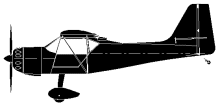
ASN Wikibase Occurrence # 48519
This information is added by users of ASN. Neither ASN nor the Flight Safety Foundation are responsible for the completeness or correctness of this information.
If you feel this information is incomplete or incorrect, you can submit corrected information.
| Date: | Monday 24 November 2008 |
| Time: | 12:45 |
| Type: |  Denney Kitfox 4-1200 (Classic IV) |
| Owner/operator: | Private |
| Registration: | N4JU |
| MSN: | C9407-0041 |
| Total airframe hrs: | 114 hours |
| Engine model: | NSI Subaru |
| Fatalities: | Fatalities: 0 / Occupants: 1 |
| Aircraft damage: | Substantial |
| Category: | Accident |
| Location: | Boulder, CO -
 United States of America United States of America
|
| Phase: | Take off |
| Nature: | Private |
| Departure airport: | Bolder, CO (KBDU) |
| Grand Rapids, MN | |
| Investigating agency: | NTSB |
| Confidence Rating: |
The pilot reported that when he was taking off on his first solo flight in the recently purchased airplane, the electrically operated propeller started to increase pitch. The pilot stated that he tried to decrease the pitch, but each time he released the control-stick-mounted propeller button, the propeller pitch would increase. After the prop went to a high pitch angle and the engine started to run "rough," the pilot elected to conduct a forced landing and turn back to the runway. A Certified Flight Instructor (CFI), who flew with the accident pilot on two previous flights, reported that the propeller controls for pitch are two buttons on the top end of the control stick (one to increase and the other to decrease pitch). He added that it was easy to inadvertently touch and to confuse which button increased and which button decreased propeller pitch. The CFI also noted that it was easy to confuse the propeller pitch buttons with similar elevator trim buttons located on the control stick. The CFI added that on several occasions he and the accident pilot mistakenly actuated the propeller control the wrong way. During the second flight with the accident pilot, the CFI said that they planned to practice takeoffs and landings. During the session, the CFI accidentally coarsened the prop pitch to its maximum setting; the power loss was "large", and the CFI closed the throttle and landed. Furthermore, the CFI reported that he had to intervene in "all, except one of the landings and most of the take-offs, performed by the accident pilot." The CFI reported that he told the accident pilot that he thought that he needed much more than two hours of dual instruction required by the insurance company.
Probable Cause: A loss of engine thrust due to the pilot's inadvertent activation of the propeller controls. Contributing to the accident were the non-standard propeller controls and the pilot's lack of experience in the airplane.
Accident investigation:
 |
|
Sources:
NTSB
Location
Revision history:
| Date/time | Contributor | Updates |
|---|---|---|
| 25-Nov-2008 10:27 | harro | Updated |
| 25-Nov-2008 11:06 | JINX | Updated |
| 21-Dec-2016 19:25 | ASN Update Bot | Updated [Time, Damage, Category, Investigating agency] |
| 03-Dec-2017 12:11 | ASN Update Bot | Updated [Operator, Other fatalities, Nature, Departure airport, Destination airport, Source, Narrative] |
Corrections or additions? ... Edit this accident description
The Aviation Safety Network is an exclusive service provided by:


 ©2024 Flight Safety Foundation
©2024 Flight Safety Foundation